Freemium or Free Trial - which business model to choose when selling software?

The monetization model is exactly that point in the strategy of each project, both cloud service and offline business, which ultimately determines its success. The correct monetization model is a kind of key to the apartment where the money is. If it does not fit, then this startup is unlikely to turn into a real business. For cloud services, various variations of free versions or a trial period have recently been popular. In this regard, we want to share an article by Lincoln Murphy, which can help you choose the right "key" to a successful business, and answer questions that are better - freemium or free trial - free trial. The article is written in the first person.
To the question which model is best used for a cloud service - Freemium or Free Trial - I answer constantly. (For those who doubt that his potential customers will even want to pay if they have a free version, we recommend reading the article “Why shouldn't software be free?” ) Companies of all stripes and sizes ask me about this - and very young startups, and established organizations that are thinking of switching to another system of work or adding new opportunities, and Internet companies reflecting on their development strategies.
It seemed to me that I told so much about all this that the answer is obvious. However, no. So I decided to talk about it so that later I could point a finger at this post if they ask me again: “Freemium or Free Trial?”
In fact, the question itself is incorrect.
Here's a letter I recently received:
“Hello, Lincoln! We in our startup have grown to the decisive moment when we need to choose the monetization model - Freemium or Free Trial. And stuck on it. So many arguments for and against each option. Will you help? ”
My answer:
“The point is not in Freemium or Free Trial, and in general these are incorrect options. You need to choose between a Freemium or Premium product. It is more correct to ask the question which one is best for your company.
If you focus on a premium product, then you can try offering to try it for free for a certain period, Free Trial. But to do this is not necessary.
It’s not only a matter of terminology, and I’m not trying to make an elephant out of a fly. ”
Each of these models has one problem - how to get paying customers in the end? This problem is clearly displayed by the scheme:
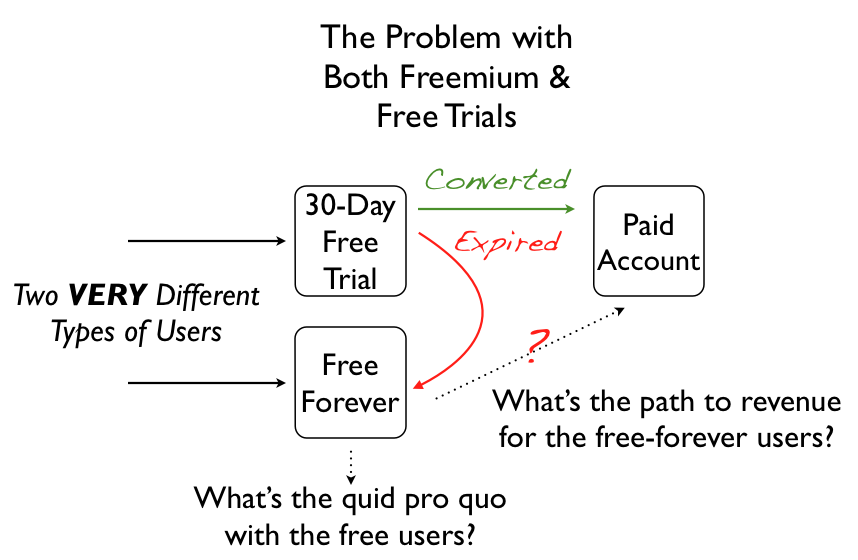
Source
From the scheme it is seen that it is most difficult to understand what is the benefit of the service from users of the free application, and how to turn them into paying ones. With a trial period, everything is more or less clear: at the end of it, users either convert to paying customers or not.
Let's dive into the problem.
What is Freemium?
Freemium is a marketing model that should generally be considered a business model, in which you provide access to some or all of your products for free forever, without any time limit.
There may be restrictions of a different kind - on available options or volumes of use - but there is no time limit, the product is always free.
What you offer on Freemium terms should initially be designed with high quality, and the design worked out. It’s pointless to use Freemium as an addition to something ready-made, it certainly will not lead to success. However, “success” in relation to Freemium is a relative concept, it is very difficult to define it.
The Freemium model is appropriate and has the greatest chance of success if the market is huge, and those people to whom you always offer your product for free will create added value (which will constantly grow) - for you, for other users and for paying customers . When you think about Freemium, you should take these circumstances into account and keep in mind that the result should be beneficial to everyone - both you, the users of the free version, and paying customers.
But how will you benefit from these more than 97% of people who are likely to never pay you a penny? Will create content? Build up volumes? Virality? Something else?
If they do not add value to the project, you are simply doing charity work. Charity is good, but not for a profit-oriented business. And you will need to think so over every aspect of your activity in order to be sure that users of the free version will certainly bring at least something to the product. There is no reason to hope that they will think of it themselves.
But shouldn't we drop -mium?
Not unless, of course, you go to create a huge customer base and sell it for billions, like Instagram ... then it's cool. Only I would not do any Freemium, I would just do Free, for free, that is, for nothing, and not worry about profit. You see, the most difficult thing with Freemium (assuming that everything else - the market, product, experience, etc. - is just fantastic), is not to get users, but to generate profit.
And the main reason for this is the Psychological Barrier.
Remember: when you cling to someone “we will always be free”, then it’s almost impossible to make this person pay for access. That's why “successful” cloud services have a conversion rate of around 3%. It's all about psychology.
I already wrote about some companies that have successfully switched from Freemium to an exclusively premium product (but, as a rule, with a free trial period). When you catch a user on "free", it is impossible to manage his expectations. You can try to prevent this by constantly offering the premium version and talking about its benefits to users of the free. I always give such advice to Freemium companies, but you only need to do this from the very beginning, otherwise you will “hook” users into a “freebie”.
From this grew the now outdated principle of “penny gap”, a penny surcharge: it is very difficult to get a person to pay at least a penny for what he now has for free.
Therefore, there are already ...
Different options for Freemium
Over the past few years, the Freemium model has moved away from its classic variation, i.e. when at some point it is proposed to pay for what you already have. Today we can meet a wide variety of Freemium options.
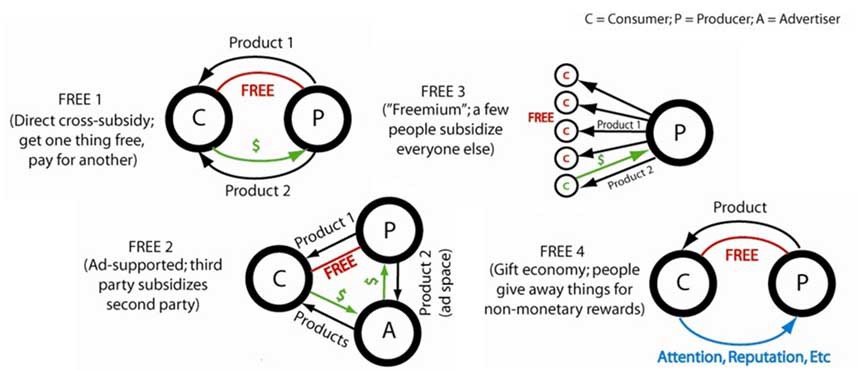
A source
In the diagram above, there are several options for the freemium model. 1st option - the client receives one product for free if he pays for another. An example is in the USA if you sign a contract with a mobile operator, you can get a phone for free. The second option - the product is free, and the service exists through advertising. This is a model of most social networks, for example. 3rd option - the company provides many products for free, but at the same time it makes money on premium products, and exists at the expense of income from them. An example is Skype, which allows a huge number of people to use their product, and its service covers income from not so many users of premium products. The fourth option, when each user brings something to the service for free, this is how Wikipedia works.
You may be charged for plugins, extensions, additional functionality, support, integration, pre-personalization, etc., and not just for the “bigger” one - in fact, it’s almost the same as you used for free. This is somewhat reminiscent of the model that B2C games use. For example, Candy Crush Saga is a Freemium game that currently generates about 950 thousand dollars a day. IN A DAY. Are you still inspired by your business idea?
One way or another, the model used in games like Candy Crush is the sale of any virtual goods, additional levels, accelerated gameplay, etc., inside the application. Obviously, Candy Crush was originally created in order to cause "addiction", and has all the necessary psychological elements. People are being conducted, real sales of virtual goods and services are growing.
This raises an important issue.
It is necessary to develop new habits.
Gradually, I began to understand that for the success of the Freemium model in B2B applications, something else is needed, and this “something” is a habit. At the same time, it is necessary to develop such a need that the application is used many times a day.
I will not say that this is necessary for all cloud services of the B2B segment, for some the metric of daily activity, i.e. the number of active customers per day (DAU) - does not play a big role. But for the success of a B2B application with the Freemium model, I think it is critical. This becomes even more obvious if we return to the principle of mutually beneficial, when every free user should be at least something useful. In this case, we can assume that those who use the application several times a day are more likely to make a profit (as well as new users and customers) than those who open it once a week. So, if your SaaS application has no chance to become a habit, there is nothing to deceive yourself, it will be extremely difficult to change people's behavior, and the Freemium model is probably not for you.
The fact that there are SaaS companies that are paid by inactive customers (at least until they understand what is happening and refuse), proves that the fact of paying for a product is not enough motivation to start using it, it’s also difficult to get to switch on a paid model, if the price is quite substantial.
Whatever model you decide on - Freemium or not - you must minimize the entry barrier and doubt and lead your users to realize (at least think about it) the value of your product for them. This means that registering for a trial version must be simple and fast, or even it may not exist at all (as in Optimzely, Gliffy or Codecademy).
Gliffyimplemented this function with the help of a button with a cool call to action - “Start drawing”.
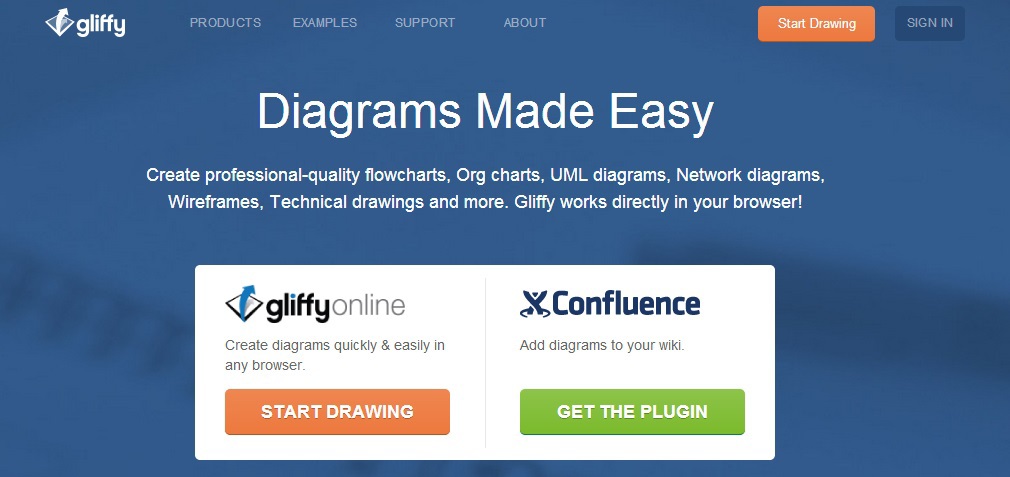
Optimizely only requires entering the site’s URL in an empty field to see how the service works.
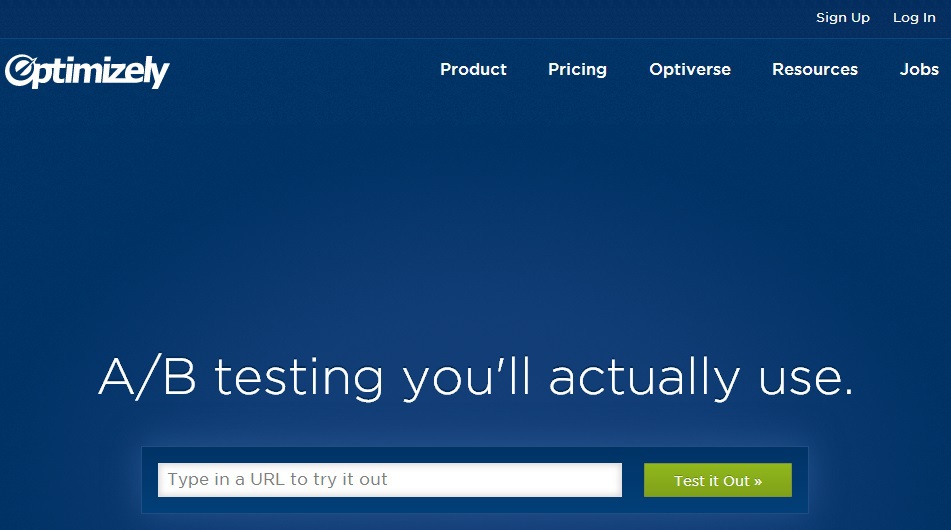
Codeacademy has done even easier: in their service you can log in via social networks.
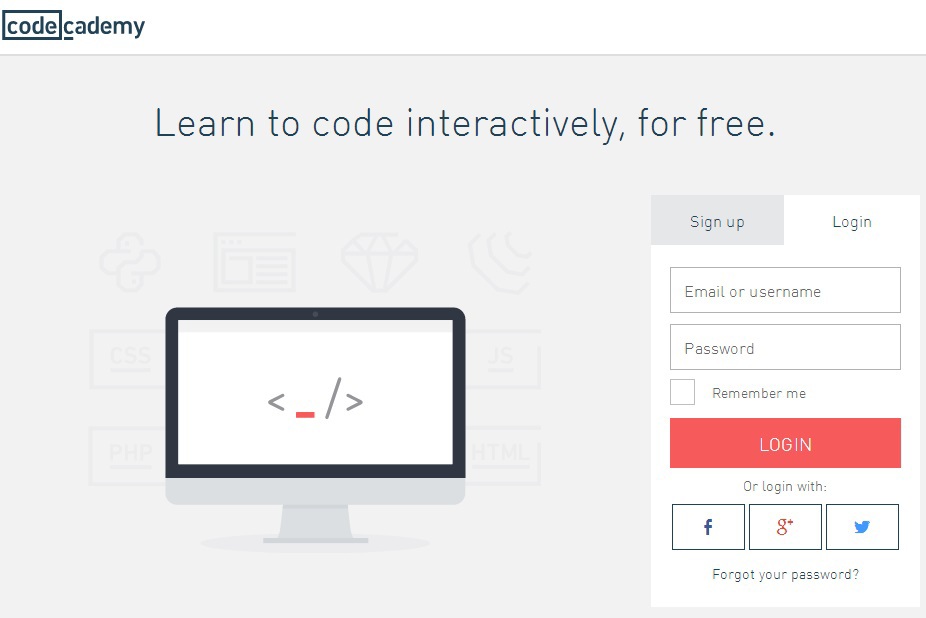
In any case, you have to understand ...
What do you want to replace with your product?
Let's go back to the games for a second. If you have already played Clash of Clans, you don’t have to pay anything to start playing Candy Crush. Just install it (possibly through ads inside Clash of Clans) - and go. You now have two games.
From a business point of view, games are just awesome. Because the user does not need to choose between them: he can have this game And that game, And one more game. But this is unlikely to work in the case of CRM: you do not need another CRM for this CRM, one is enough for you.
It is much easier to get a user to try a new game (and try to quickly hook it) than a B2B application. Games are set under the influence of impulse, there are no payment procedures, agreements, marketing research, painful transition, recovery, etc. The user does not bear the costs. It is more difficult to sell a SaaS service from the category of products to choose (when only one is required).
As I said, people and companies use only one CRM, only one HR application, only one cash register system, and so on. Of course, in different departments they can use several SaaS solutions for similar tasks, but each of them uses only one.
In general, you should know what place you will take in the familiar world of your client, whom and what you will supersede if they choose your solution: competitors, home-made solutions, free resources or ... nothing (which, in fact, should be troubling) .
The more solutions you replace, the more value your product can have. But the more expensive the transition to your decision is and the less likely it is to become a habit to use your product, the more likely that the Freemium model will not work for you.
Whatever model you use - Freemium or not - you must understand why you are offering it and how it will work with your application, in parallel with old familiar solutions or setting them aside. It’s not easy to understand.
If you do not replace anyone, i.e. Your potential customers are not currently engaged in what your product provides; be aware that you are opening a new market niche. It can be very profitable, but it is guaranteed to require a lot of effort, time and money. Although, it is possible that this is ideal for Freemium.
Wait a minute ... I forgot something else.
I didn’t say this before, they distracted me.
People these days are so scattered, they are so easy to distract!
Of course, we can assume that the reason for our absent-mindedness is in ourselves (for example, I can try to pass the 70th level of Candy Crush, while simultaneously making changes to the client’s profile, sending an email and reading Twitter), but that’s not the point.
We all suffer from a lack of time and resources. And you need to understand that, by offering our application, we invade the world of a scattered person, whose brain is already overloaded with information. And we must work with this, take this into account, and fight this. And do not forget about it.
How about a free trial, Free Trial?
More precisely, what about the combination of Premium + Free Trial?
Firstly, everything that I said about the cost of the transition, lack of resources, habits, etc., applies to Free Trial. It applies, but does not cause such problems as in the case of Freemium (if your product meets the expectations of customers), because it is what it is called: a free trial version of a paid solution (commercial, premium, very valuable).
Freemium is given free and forever, and Free Trial is given for a specific time. And when time ends, there are two ways: to pay or refuse.
Although there are companies that manage to combine both models in their tariff plan, for example Twigmo.

A source
Therefore, if your application does not meet the “requirements” described by me for a successful Freemium, then you can go the more traditional way and not use it. For example, it is aimed at a small market, or free users cannot bring enough profit (they will not be scattered around the world, and the network effect will be minimal), or it is very difficult to turn the use of this product into a habit. This means that you have a worthwhile offer, which, it seems to you, can bring real money and become the basis of a small $ 100 million business. Then ask for a fee for it from the very beginning, and then offer a free trial version of this paid product.
I’m talking about the free trial, because I think this is the best way. If you plan to take at least $ 1 for a trial version or even just ask for your credit card information for the future, there are no guarantees that you can attract customers using this method.
From my own experience, I can say that the offer of just Free Trial - a free trial - is already increasing sales. But if this version is poorly designed, it’s difficult to get used to it, it’s difficult to implement it, it does not convert customers well, it will hit the cost of attracting one client in terms of indicator.
There are thousands of tips on how to organize Free Trial in the most efficient way, and in addition, free trial versions are a simpler approach without Freemium’s human psychology flaws.
However, there are companies that even refuse to provide a free trial period, and immediately demand money from customers, for example, Assis.
Old tariff selection page, where there is a free trial period.
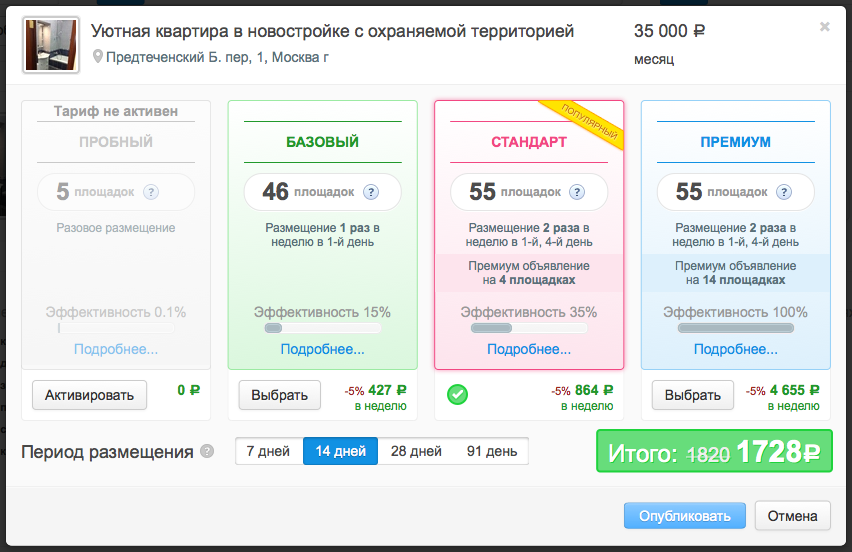
New tariffs, exclusively paid
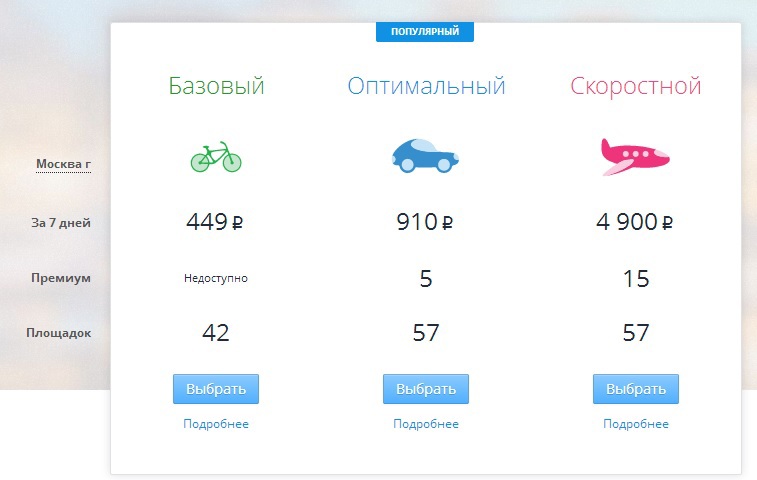
Source
So what is better?
I can’t decide for you. Giving advice is nice, but this problem requires the attention of your internal entrepreneur. Because in the end, this is likely to be an intuitive solution, even if you shoveled mountains of market statistics.
The reality is that if your target market is not sufficiently branched and potential customers do not communicate with each other (i.e. it’s hard to get them to tell each other even about an interesting article, not that a useful B2B application), then you may not succeed act on it quickly so that the Freemium model works effectively.
On the other hand, if this is a new idea for your market, it is not a fact that it will not work.
I urge you to return to basics and think carefully. And then, I hope you make the right decision and take over the world!
Source: http://sixteenventures.com/freemium-or-free-trial
Only registered users can participate in the survey. Please come in.
What do you prefer for your service:
- 30.3% Freemium 93
- 38.5% Free Trial 118
- 15% Both options at the same time 46
- 16% Neither 49
